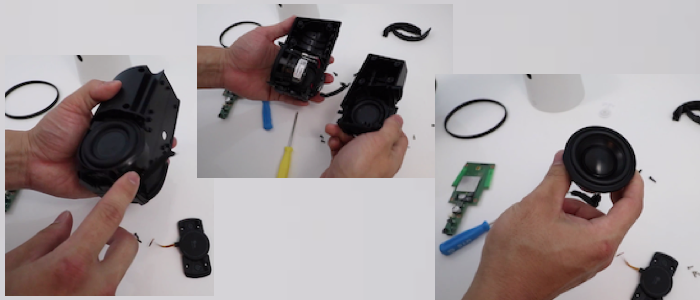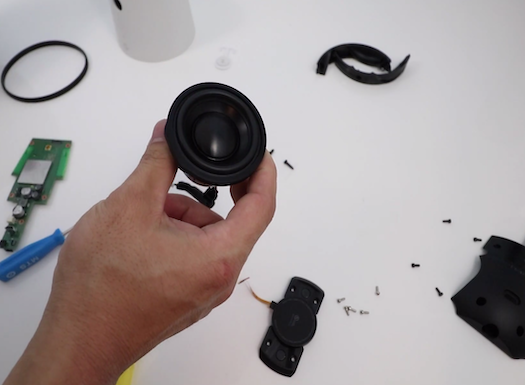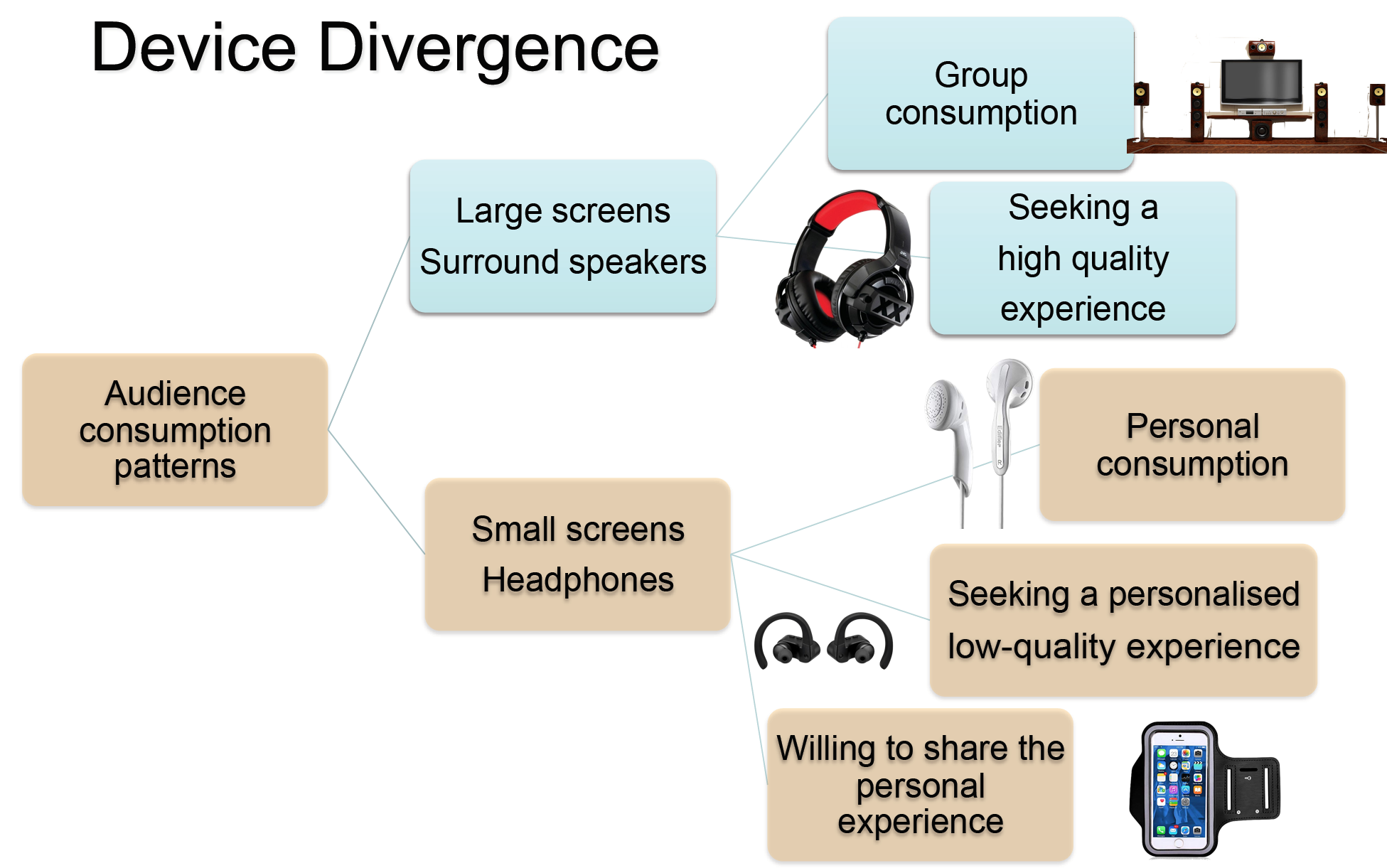Steve Ahern’s assessment of the continuing evolution of audio devices and consumption.
A few years ago I started tracking the divergence of media consumption devices, as some got bigger and some got smaller.
There was a trend towards big home theatre screens and surround sound speaker configurations, but, at the same time, there was a demand for more personal consumption technology as well.
This was a slide that I was using from about 2013 to explain the divergence.
Out of home consumption was happening on smaller devices and consumers were willing to sacrifice quality by watching video on small low resolution screens, and consuming thin audio, delivered by highly compressed mp3 files that stripped out the bass and dynamic range to save space on the storage device.
Meanwhile, house-proud home theatre owners were placing their big heavy tvs on solid stands, or using data projectors to fill the whole wall with pictures. They were running monster cable around the room, installing sub-woofers and bolting Bose speakers to the walls in the 5.1 surround configuration, to enthral their guests with the quality of their home theatre set up.
Today, as technology is changing, I think there is another trend happening, the technologies and consumer behaviour patterns are converging again.
Consumers have increased their expectations of portable media devices. They now want them to access plenty of content and to deliver it in higher quality to a richer resolution screen or a better pair of , possibly unwired, earphones, in a more convenient manner.
Smart phones have got bigger and better, so have tablets.
Quality headphones have incorporated noise cancellation.
Earbuds, once thought of as necessarily low quality, have incorporated noise cancellation and developed new shapes to better sit in or over the ear.
Big screen tvs are thinner, lighter and require less real estate to mount them. 4K screens are available and we are fast heading towards 8K resolution. The next generation of screens can be rolled up like paper and easily moved, further blurring the line between fixed and portable media.
Wifi, rather than cable, now connects the speakers, and allows the audience to move their video and audio back and forth from the small to big screens in their connected households.
Storage is no longer an issue, as we can buy hard disks with terabytes of storage or keep our content in the cloud.
We can rent unlimited choices of music and videos for less than the cost per month of buying an Album or a DVD.
Then comes smart speakers. Now we don’t even need a remote control, we can talk to our Google or Alexa app-enabled smart speaker and request audio and video replays, streaming music services and OTT delivered video on demand.
Artificial intelligence will learn our preferences and keep track of what we have watched and listened to, ready to play back from where we left off or to find new songs like the ones we listen to most, all by voice control.
Home devices will act predictively, not only in response to a specific commands, such as setting up Google or Alexa morning routines. Say ‘good morning Google’ and it will tell you the weather and give you a traffic update about your route to work, say ‘goodbye Alexa’ and it will turn off your music stream, dim the lights and check that you haven’t left the kettle or the iron on in an ‘intelligent ecosystem.’
The ‘goodbye Alexa’ skill could also activate ‘Kevin’ if you are worried about burglars – Kevin will replay sounds of you moving about your house, turn on and off lights and play the radio and tv at random times to make people think there is still someone home. ‘Kevin’ was demonstrated at this year’s Consumer Electronics Show in America.
All of this will soon get even faster as 5G mobile data penetrates the market and increases speeds. 5G trials are already well advanced in Australia.
Sales of smart speakers have exploded since they were introduced in 2015, with 80 million units sold to date and sales still growing exponentially to an expected 200 million by next year (CES report)
With all this, there are a few things still to be thought about to ensure the audio experience is as good as it can be in this reconvergent audio visual world.
I have been testing several Google and Alexa smart speakers for months now (I will give you more updates as the year progresses), but already there are a few things I have noticed about the hardware:
The upper end smart speaker models have tweeters and woofers to deliver full frequencies and use air gap reflective sound design to enhance the sound quality.
Voice recognition (once it is set to Australian English) is generally good. Google seems to have slightly better microphone pick up range than Alexa, although Alexa has more microphones in it.
I have also noticed things about the software and radio delivery, but I will save them for another article.
My biggest objection is the fact that most smart speakers are mono. Come on… really. When music is recorded in stereo, and radio and streaming services deliver stereo to your device, why play it through only one speaker?
Prove it for yourself, take it apart and count the number of speakers in it (or watch this video where Brandon Geekabit takes one apart for you).

Yes, I know I can connect two wifi smart speakers and hear the stereo, but I want to hear it from the one speaker that I have strategically placed between my kitchen and living room.
And then there is the question of height. Since smart speakers are generally round, why not send the sound upwards as well as horizontally using onmidirectional speaker technology.
There are many dumb bluetooth speakers that are stereo (a favourite of mine is the JBL Flip 4 stereo speaker), so why couldn’t the smart speakers just go that extra mile and include two channels and two speakers.
But wait… salvation may be near. I just experienced Fraunhofer’s object-based immersive sound technology.
If the coming generations of smart speaker can use better speaker configuration and object-based data to manipulate the sound experience, then all will be solved. I will be waiting, but up until then, please, Google and Alexa, put more than one speaker in your devices and deliver stereo through them.
I fell better now, I’m going for a cuppa and a good lie down.
This is one in a continuing series of articles about smart speakers we are doing this year.
See also: James Cridland’s recent article on Speakers V Headphones, and check out other reports here.
About the Author
 Steve is the founding editor of this website.
Steve is the founding editor of this website.
He is a former broadcaster, programmer, senior executive and trainer who now runs his own company Ahern Media & Training Pty Ltd.
He is a regular writer and speaker about trends in media. More info here.



